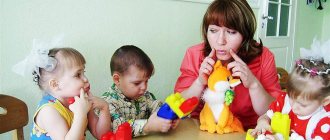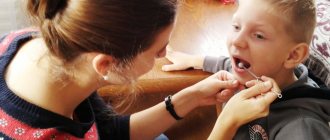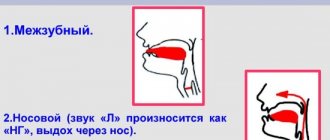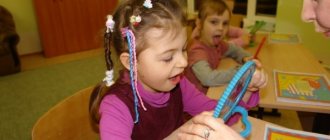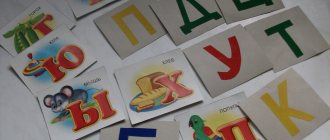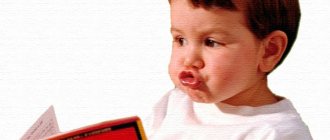Speech therapy probes are a stainless steel wire probe and are used to influence the tongue and other organs of the human articulatory apparatus during speech therapy correction. The method of probe correction of sound pronunciation is an exclusively Russian invention. In Western countries, speech therapists do not know the technologies for working with these tools.
Speech therapy probes are used as auxiliary instruments. In practice, the following types of probes are used:
- staging (for producing sounds mechanically);
- massage (for speech therapy massage).
Indications for massage with a speech therapy probe
A speech therapy probe is a device with which a speech therapist exerts a mechanical effect on the baby’s articulatory organs in order to develop speech skills and restore correct sound pronunciation.
Probe massage is carried out in cases where simpler (articulatory, respiratory, imitative, transitional) methods cannot correct the child’s incorrect pronunciation. In addition, the use of speech therapy probes is considered mandatory for the following speech disorders:
- dysarthria – associated with problems of the central nervous system;
- alalia – occurs due to damage to the areas of the cerebral hemispheres responsible for speech;
- rhinolalia - manifests itself due to obvious defects in the oral or nasal cavity - this includes nasal pronunciation;
- dyslalia – not associated with hearing impairment or central nervous system problems. It is present in physiological form in every person at a certain stage of development (up to 5 years);
- stuttering;
- aphasia – problems with speech after a stroke (for adults).
Massage procedures will also be useful for general delays in speech and mental development, increased or decreased tone of the speech muscles, and cerebral palsy.
Contraindications
Massage courses are prescribed by a neurologist after a complete examination. It should not be used for epilepsy of various forms, as it can provoke seizures.
Temporary withdrawal is given for any infectious or somatic diseases. Probe massage should not be performed for stomatitis, caries, gingivitis, or skin diseases. Herpes and oral infections also serve as a medical outlet for procedures.
It should not be done if there is strong pulsation of the arteries, high blood pressure, or poor physical well-being.
If you have nausea, vomiting, or fatigue, you cannot conduct a session; it is better to reschedule it for another time. A speech therapist examines each child before performing a massage.
Types of probes
The author of the probes used by most speech therapists and the probe massage system is Elena Novikova. According to her methodology, 11 main types of probes are distinguished:
| Probe name | Appearance | Massage areas | Functions | Necessary techniques |
| 1.Fork | fork with two curved points | Tongue (I), soft palate (MN), lips (G), cheeks (CH), cheekbones (C) | promotes intense muscle contraction, | Tingling, tingling with pumping |
| 2.Eight | number "8" or symbol of infinity | I, S, Sh, G | drowns the muscles, makes them work actively, setting the sound “R” | Rubbing movements in place along and across |
| 3,4,5.Sleds (large, medium, small) | resemble a sleigh | I, S, MN, G, SH | stretching the frenulum under the tongue, relaxing and activating muscles | Sliding movements in different directions |
| 6.Hatchet | looks like a razor | mostly language | normalizes muscle tone, increases mobility and muscle contractility | Chopping with firm pressure (frequent, small intervals), sliding movement like a “shaving” |
| 7. Cross | cross with smoothed edges, perpendicular to the handle | I, S, Sh, G | pumping of the tongue muscles, production of the sounds K, G, X, R, Sh, Zh, Shch, Ch, Zh | Scrolling, pressing, pressing the tongue to the root, pushing back with the tongue |
| 8.Pusher | ring perpendicular to the handle | I, MN, SH, G, S | muscle activation and relaxation | Pressing, scrolling, “Spring” exercise with the tongue (to the root) |
| 9.Pliers | 2 adjacent, collapsible teardrop-shaped frames on the handles | I, Ш (inside, outside), G, S | warm-up, muscle activation | Bending, turning, rolling of tongue, cheeks |
| 10. Swan | loop on a curved leg | MN, SH, S | the most convenient probe for massaging the soft palate | Pressing, scrolling |
| 11. Bridle | Bridle, horseshoe | hypoglossal ligament | Checking the condition and tightening the hypoglossal ligament | Pull the tongue upward |
Most of the devices are used to warm up, stimulate and relax the tongue muscles. Many probes are interchangeable; usually 5-6 tools are enough for massage. In addition to the main probes, speech therapists often use the following types:
- staged (narrow elongated loop) - to form a groove when pronouncing whistling sounds;
- Koritsky spatula (an oval frame extended to its full length) - for massaging the side edges, as well as the lower part of the tongue, making hissing sounds and “P”;
- spatula - for stroking, tapping, passive gymnastics;
- ball – for performing various exercises (rolling, spinning a ball), making the sound “P”;
- hedgehog (roller with convexities) - for massaging the lips, lingual, zygomatic, chewing muscles with muscle hypotonicity and paresis of the articulatory apparatus.
General recommendations for conducting
Massage with speech therapy probes is carried out in courses. Each course is designed for 8-10 sessions. It is allowed to do the procedure every day, but it is better - after 1-2 days, so as not to get muscle fatigue.
A total of 3-4 courses are carried out, with a break of 30-45 days. Sometimes one course is enough to normalize pronunciation. The duration of the session depends on:
- patient's age;
- complexity of the defect;
- child's reactions.
You need to start with 5 minutes. Then for 1-3 year old children, bring it up to 5-10 minutes, for 3-7 year olds – up to 15 minutes, for schoolchildren – up to 20-25 minutes. Each movement is done 30 times.
General recommendations for preparing for a massage should be followed:
- The room should be well ventilated, bright, clean. The atmosphere is cozy.
- It is necessary for the patient to be calm and peaceful. You should not carry out therapy if the baby is agitated, aggressive, or too depressed.
- If for any reason a child has a negative attitude towards probes, you should let him touch, look at the instruments, and play with them a little. You can say that they are magical, they teach you to speak.
- In case of an extremely negative (even hysterical) reaction, it is better to keep the sessions short – 5-10 minutes. At the same time, they begin by stroking the cheeks, lips, and tip of the tongue.
Staging other sounds
Sound setting [U].
Stretching your lips forward, pronounce the sound [u], then close and open your lips with your fingers. Or do the “balalaika” exercise with your fingers on your lips at a faster pace. The sound can be immediately entered into words: paper, Pinocchio, etc.
When replacing [B] with [P], you should initially teach: to distinguish sounds, to distinguish incorrect pronunciation from correct, to teach to include the voice at the stage of preparing the articulatory position.
Sound setting [B].
Stretching your lips forward, pronounce the sound u, then mechanically press your lower lip to your teeth.
Bite the edge of your lower lip, slightly stretch your lips into a smile and hum, then sharply open your mouth and say [A]. Particular attention should be paid to the duration and force of exhalation on the lower lip.
Sound setting [D].
- Pronounce the sound [B] with your tongue stuck between your teeth, then use your fingers to spread your lips.
- From the sound [Z] or [Zh]. At the moment of pronouncing, use sharp movements of the spatula to press the tip of the tongue against the alveoli.
Advantages and disadvantages
Massage with speech therapy probes, when performed correctly, gives good results. Its positive effect on the patient’s body is expressed in the following:
- speech development, improvement of sound pronunciation;
- voice normalization;
- restoring proper breathing;
- eliminating neurological disorders, improving the functioning of the central nervous system;
- normalizing muscle tone;
Universal oral massage can also be performed on healthy children at the initial stage of speech development. This will contribute to the correct formation of speech skills.
There are few disadvantages to probe massage procedures, but you shouldn’t turn a blind eye to them:
- If done incorrectly, the child's pronunciation may deteriorate.
- Massage manipulation alone is not always enough to restore speech. You cannot ignore other recommendations of the speech therapist: taking medications, physiotherapeutic procedures, articulation exercises.
Tool handling and storage
Tools for massage procedures need to be chosen from high-quality, proven companies. Main materials are titanium or stainless steel.
An important element of preparation for massage is the processing of probes. Each set of tools is used no more than 1 time. After the patient, the probes must be processed:
- Immediately after use, wash under running water and detergent.
- Place in a bath with a sterilization solution for 30-60 minutes (Alaminol, Veltolen, ID-212, Virkon, Vapusan-2000, Lisetol LF, Septodor, Erinox and others ).
- Rinse under running water.
- Sterilize in a metal sterilizer (by boiling for 10-15 minutes from the moment the water boils) or in an autoclave (steam). Plastic probes (balls) do not withstand the sterilization process, so such instruments can only be individual.
Treated devices should be stored in a UV bactericidal chamber to avoid secondary colonization by microorganisms.
Carrying out at home
Sometimes parents, for some reason, are not able to take their child for massage treatments to a speech therapist. Then you can spend them at home. At home, to normalize pronunciation, you can do 2 types of speech therapy massage:
- faces;
- articulatory apparatus.
Speech therapy facial massage
The procedure is simple and consists of sequential massaging of certain lines:
- from the center of the forehead to the temporal region, then from the eyebrows to the hairline;
- from the corners of the lips to the temporal region, then back;
- from the tip, middle of the nose, bridge of the nose - to the base of the wings of the nose;
- along the nasolabial fold from the wings of the nose;
- from the center to the corners of the lower and upper lips;
- from the center to the earlobes;
- from the sternum along the neck to the chin to the earlobes, back along the shoulder line.
Movements along all lines are stroking, rubbing, vibrating. The exception is the nasolabial fold and the last final stage from the sternum to the chin - here the movements will only be stroking.
Speech therapy massage of the speech apparatus
Massaging the organs of the oral cavity has a strong effect on the articulatory apparatus and many other systems of the body. Before doing it at home, you need to consult with a speech therapist so that he can identify the problem and suggest ways to solve it. It is also advisable to spend the first few sessions with a specialist, and then begin independent therapy.
Massage tools can be professional or taken from the everyday environment. If it is not possible to purchase speech therapy probes, you can use your fingers, a teaspoon, a toothbrush, or cotton swabs.
Before the procedure, it is recommended to warm up the tongue: swaying from side to side, licking lips clockwise, clicking (horse), pricking the cheek with the tongue and other exercises.
Conditions:
- The massage therapist's hands must be clean, without damage, and nails must be trimmed.
- Instruments are washed and disinfected.
- The child is placed on a massage table or on a hard mattress so that he is comfortable. You can also sit him on a chair with a high headrest.
- Place a clean towel or gauze under the chin and on the chest.
- Gauze is placed under the tongue to absorb excess salivary secretions.
- The tip of the tongue can be wrapped with gauze or a cloth napkin - this makes it easier to hold it so that it does not slip.
The process of universal speech therapy massage at home:
- Grab the tip of your tongue and move it left and right, up and down. Then it is pressed to the root and pulled back.
- Use your thumb to stroke the organ from the center to the edges, then make circular movements.
- Stroke your tongue from above and below. You can do this with the smooth side of a spoon.
- Make zigzag movements along.
- Perform various vibration movements: rocking, rubbing, tapping.
- Using a toothbrush, apply pressure and rocking pressure on the tongue.
- Massage the frenulum by moving your thumb or the convex side of the spoon upward.
- Massage the surface of the tongue with a rough cloth or soft toothbrush.
You can also gently massage the inside of your cheeks and lips.
Remember:
- If it is difficult for a child to relax his tongue, then an adult can do this himself by shaking the articulatory organ.
- With hypertonicity, all movements should be weaker and calmer. The direction when moving along the tongue is from the root to the tip.
- With hypotonicity, movements are more active and strong. The direction along the tongue is from tip to root.
It is easy to determine the tone of the articulatory apparatus:
- with increased or hypertonicity, the tongue is compressed like a sausage, too tense;
- with decreased or hypotonicity, the organ, on the contrary, is too relaxed and cannot maintain the same position for a long time.
Setting sounds [L], [L]
A set of exercises for the sounds L, L: “needle”, “fast snake”, “turkey poults”, “dipper”, “horse”, “painter”, “woodpecker”, “steps”, “steamer”, “hunter”.
Methods and techniques for producing the sounds L, L..
If there is no sound, production is carried out in 2 stages:
- Setting [l] interdental. The child is asked to pronounce the combination ya. In this case, [s] is pronounced briefly, with tension in the organs of articulation, then pronounce the combination with the tongue stuck between the teeth. When the sound becomes clear, it is necessary to slow down the movement of the lower jaw. In children with an erased form of dysarthria, it is recommended to fix this sound in syllables and words.
- Next, move the tongue to the tooth position, pressing the tongue firmly against the alveoli and pronounce ly-ly-ly.
With nasal pronunciation, production is carried out in the same way as in the absence of sound. First of all, it is necessary to develop the correct direction of the air stream.
Setting the sound [L] during interdental pronunciation. If a child pronounces several groups of sounds this way, special attention is paid to the development of motor skills of the tip of the tongue. The performance is carried out as in his absence. You can use mechanical assistance - use a spatula to lift the tongue by the upper incisors and hold it until this position is fixed in the child.
Setting the sound [L] when replacing [l] with the sound [th].
When replacing [l] with the sound [th], with the mouth open, place a round plastic tube on the middle part of the back of the tongue, and lift the tip of the tongue by the upper incisors.
When replacing the sound [L] with a soft sound [l], you can use probe No. 4. Ask the child to repeat the syllable [la] several times, then insert the probe so that it is between the hard palate and the middle part of the back of the tongue. Press the probe down on the tongue (to the right or left). To lower the middle part of the back of the tongue, you can perform the following exercise: rest your tongue firmly on the upper incisors and pronounce the syllable ky several times. Then sharply open your mouth (you can help by pressing on your chin). This technique is not suitable for children with lateral pronunciation.
When pronouncing [a], you need to “knock” your tongue on the upper incisors. The exhalation should be hot, smooth and continuous.
In some cases, a faster and clearer sound is obtained in the reverse syllable. Pronounce [a] for a long time, then “bite” the tip of the protruding relaxed tongue: [aaall-aaal-aallaallaaa].
From the sound [v] is placed in a mixed way. Ask the child to pronounce the syllable you with his tongue inserted between his lips, then push back the lower lip with your finger.
A similar technique can be used from the combination [bl] (“turkey”). While pronouncing the combinations blblbl, gradually move your lips to the sides and your tongue deep into your mouth (first along the lips - [blblbl], then along the upper teeth and then along the alveoli).
Invite the child to put as much tension as possible in the shoulder girdle area, for which you need to bend your head forward and in this position, sound the sound [l] as low as possible.
Using two fingers - index and ring - apply light pressure on the outside of the neck so that each finger is at a point at the inner edge of the posterior third of the left and right branches of the lower jaw.
When pronouncing a sound from the side, you must first achieve the correct air flow and straight position of the tongue. The child should be switched from incorrect articulation. Methods No. 1, 8,9 are suitable for this.
The main difficulty in producing the sound [L] is that while pronouncing the sound correctly, the child continues to hear his previous sound. Therefore, it is necessary to attract the child’s auditory attention to the sound that is produced at the moment of its production.
Tips for parents
In order for speech therapy probe or home massage to bring benefits and only positive emotions to the child, parents should follow these tips:
- Use all the techniques recommended by the speech therapist to resolve the problem. This can be not only massage, but also speech therapy exercises, communication with a psychologist, medication treatment, and physical therapy.
- If massage procedures, despite all the efforts of the specialist, cause discomfort in the child, you need to come up with some way to encourage him to visit the speech therapy room. For example, promise to buy a toy or sweets that the baby would like to receive.
- Communicate more with your child, monitoring your pronunciation and his. Correct his mistakes, pronounce the correct pronunciation several times.
- Do articulation exercises more often.
- Play speech therapy games with your student to help eliminate pronunciation problems.
- Don’t worry if after the first or second course of procedures there are no results: the baby still speaks incorrectly. Often 3-4 courses are required to achieve the desired effect. Everything will definitely work out! The main thing is to believe in your strengths and the abilities of your child.
Related posts:
- Massage for speech development - speech therapy interventions Massage for the correction and development of speech is carried out in various ways....
- Logorhythmic classes and correctional means By various means, speech therapy classes contribute to the effective correction of speech in children...
- Rhoticism in speech - complete information Rhotacism (problem with the sound [P]) is the most common disorder in children...
- A child does not know how to say R - we’ll show you how to teach it. To teach a child to pronounce the letter R, you need to regularly perform special...
Sound setting [Y]
Set of exercises:
- "Let's brush our teeth"
- "needle",
- "slide",
- "coil",
- "tongue is strong."
Methods and techniques for producing sound [Y].
It is often possible to create a sound by imitation. It is useful to add the display of articulation and the tactile sensation of the expiratory stream during prolonged pronunciation [yyy].
The child pronounces the combination [aia] or [ia] several times. The exhalation intensifies somewhat at the moment of pronouncing [i], and immediately, without interruption, [a] is pronounced. You can put the sound immediately in words where the [th] sound is first.
The child pronounces the syllable [zya], repeating it several times. During pronunciation, the speech therapist presses the front part of the back of the tongue with a spatula, moving it back slightly until the desired sound is obtained.
When pronouncing the sound [хь] for a long time, pay attention to the very thin gap between the teeth and increased exhalation.
If the sound [th] is replaced by the sound [l], differentiation should be made by lowering the tip of the tongue down with a spatula or as shown.
